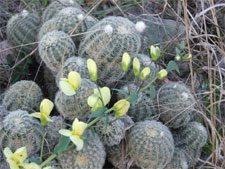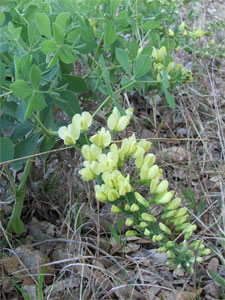Native Plant Road Trip – March, 2008


Red Buckeye (on the first page of e-gardens) and Yellow Baptisia are both “survivors.” Yellow Baptisia will share growing space with cacti.
Photos by the author.
Red Buckeye/Yellow Baptisia
My rational side almost talked me out of hitting the road this month (“Gas prices and dirty dishes and piles of laundry! … oh my!), but my id screamed loudly and the sun shone brightly, so reason was outvoted and away I went.
Dropped south again, opting as usual for the small roads, winding my way through Thorp Spring, Glen Rose, Walnut Springs, Valley Mills, Rosebud, Moody, and other towns with interesting names. Forgot to slide over to Dime Box and Old Dime Box to hear the history of those little places … next time.
Found myself at a funny old steel bridge that crosses Cummins Creek, one that plays an interesting “singing buzz-saw” kind of melody when driven over. About ripped the door handle clean off when I spotted a grove of Red Buckeye (Aesculus pavia) in full flower. This small native tree sports large, lovely, schefflera-like palmate leaves and a pyramid of beautiful red-coral blossoms atop each twig in springtime, and the sight of dozens of specimens crowded together was something to behold. Sun shafts easily penetrating the dense but still leafless forest canopy created an ethereal ambiance to this little patch of heaven just south of Round Top, and a literal cacophony of bird songs hung in the air so thick you’d swear you could see them as small wisps stringing off the wingtips of passing butterflies. Lovely and unfamiliar (to me, anyway) wildflowers grew in billows at the feet of these trees, almost obscuring from view the tender, newly emerging foliage of the blanket of poison ivy strewn across the forest floor. Kind of reminds me of the scene painted with those credit card offers that fill my mailbox these days. In both cases, best stay close to the road….
I ambled on down through Round Top, amazed at the enormous tent city rising from the pastures in preparation for that twice-a-year (April and October they said) antique event that apparently everyone but me has attended. (I’m told even Martha Stewart makes her way down to Texas to check this out.) The bluebonnets, paintbrush, and phlox are peeking up cheerily in the midst of all this madness, and I hope they don’t get too trampled in the fray.
Took a few minutes to take pictures and empty my wallet at the Antique Rose Emporium, which is about the nicest place in the whole state to do either. Shook hands with the rose man himself (Mike Shoup) and congratulated him on the new children’s garden. On the way out of town, I bumped into a 1950s-style diner at a little airport – the food was great and the poodle skirts were fabulous.
An hour and a half shy of sunset, I’m being tossed about in the back of a four-wheeler lumbering across an old family farm that serves as a cattle ranch these days. Fresh leaves of blackjack oak shine in the sun, and the season’s first crop of grasshoppers take flight in our wake. At first glimpse, I thought I was seeing some False Indigo (Baptisia australis) foliage off in the taller grasses, and I got a little excited, as this is one of my favorite herbaceous perennial wildflowers, with its strange, rubbery stems and blue-purple inflorescences. Or maybe it was B. alba, with its blue-frosted white bloom spike…. But as the soil got thinner and the grasses got smaller, it was clearly a new wildflower for me …Yellow Baptisia.
This little beauty has a peculiar flowering habit: the creamy-yellow flower spike emerges from the side of the plant instead of out the top. Irresistibly touchable and shaped like a hybrid between a bluebonnet and a wisteria, this inflorescence almost floats in the palm of your hand. Scentless, yet soft as a downy feather, it endears itself to you in an instant. All of this delicacy belies the site – a sparsely vegetated, rock-strewn, short-grass prairie. Occasionally, Yellow Baptisia (B. bracteata) will share a root zone with one of the many cacti dotting this field, and both survive well here because cattle won’t eat either. I search for and eventually find one of the curious, rounded black pods produced last year. A finger thump and a quick shake and it rattles brightly … loaded with seeds. I tuck it into my pocket, knowing full well it will take several years and some luck to get a plant established on the prairie next to Chandor Gardens.
There actually is a connection between these very different plants, the woodland Red Buckeye and the prairie Yellow Baptisia. They both escape the brunt of the summer heat by going dormant by July. The Red Buckeye drops all of those exquisite leaves and returns to little more than a few vertical sticks. The Yellow Baptisia’s leaves dry to ashen gray, and usually detach in the wind, leaving no trace above ground of the thick, fleshy roots below. Survivors, these two….
As the sun slips away, I am reminded that much of this great state’s natural heritage is still intact, though in much smaller parcels than yesteryear. Many of these parcels are being stewarded by a new generation of Texas ranchers, folks who have developed some of the best strategies around to balance ecological and economic sustainability, to ensure future generations can learn to work and to love our important but underappreciated prairie ecosystems. Like many people, I used to look at ranching only as a problem … now I know that it may well be one of the best solutions.
Check out www.bambergerranch.org for more info on sustainable ranching. For a great article on Baptisia, go to www.plantdelights.com/Tony/baptisia.html
About the author: Steven Chamblee is the chief horticulturist for Chandor Gardens in Weatherford and a regular contributor to Neil Sperry’s GARDENS magazine and e-gardens newsletter. Steven extends an invitation to Chandor Gardens:
Plan your springtime trip to Chandor Gardens! We officially open the first weekend in April (April 5 – 6). This year we bring you a little blast from the past with a special $1 admission (just like Ina Chandor used to charge in 1978), live music, a special exhibition of five antique cars, and special Shakespeare vignettes to be performed in various places in the garden. The brand new gift shop will be open, featuring treasures from Parker County and around the globe. Refreshments will be available. Come on out and see us!
Hours are 9 a.m. – 3 p.m. Saturday; 1 p.m. – 5 p.m. Sunday. For more information, call 817-613-1700 or go to our website, www.chandorgardens.com
Steven adds:
Spring fever is at full throttle, and everyone is asking me where to go for “the good stuff.” Here’s what I recommend:
Parker County Master Gardener Plant Sale — April 12, 8 a.m. – noon. Go to www.pcmg-texas.org for more info.
Grapevine Botanic Garden Plant Sale — April 12, 8 a.m. – 1 p.m. Go to www.grapevinegardenclub.com for more info.
Heard Natural Science Museum’s Annual Native Plant Sale — April 12-13. Go to www.heardmuseum.org for more details.
Southside Preservation Hall (Fort Worth) — April 24, 25, 26, 9 a.m. – 9 p.m. Go to www.southsidepreservation.com for more details.
Garden Gala Plant Sale at Stephen F. Austin State University — April 12, 9 a.m. -2 p.m. Go to http://arboretum.sfasu.edu for more info.
Dallas Arboretum Plant Sale — April 19-20. Go to www.dallasarboretum.org for details.
Fort Worth Botanic Garden Spring Plant Sale — April 19, 9 a.m. – 2 p.m. Go to www.fwbg.org for more info.
